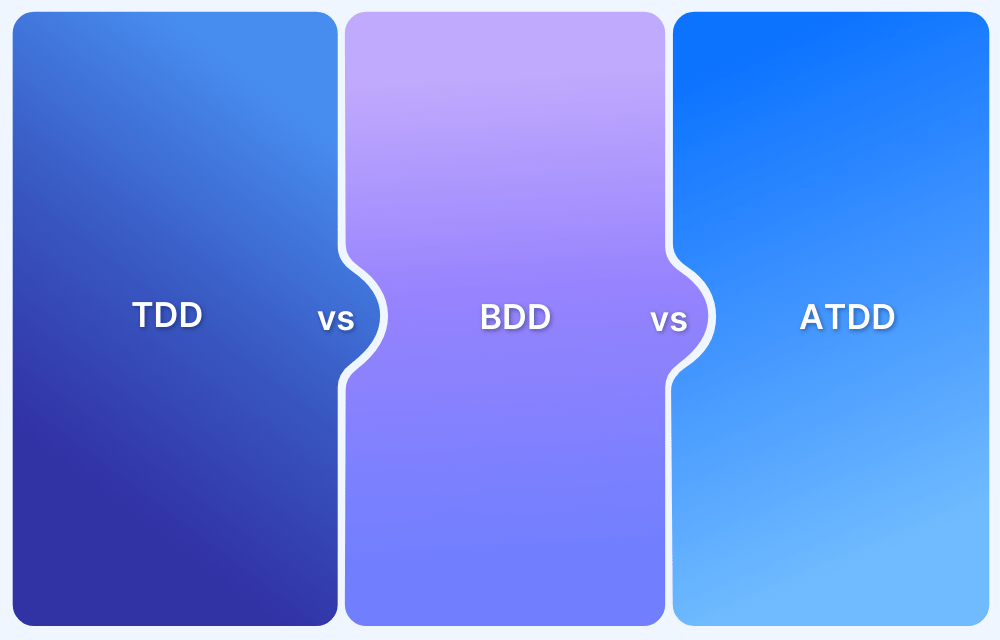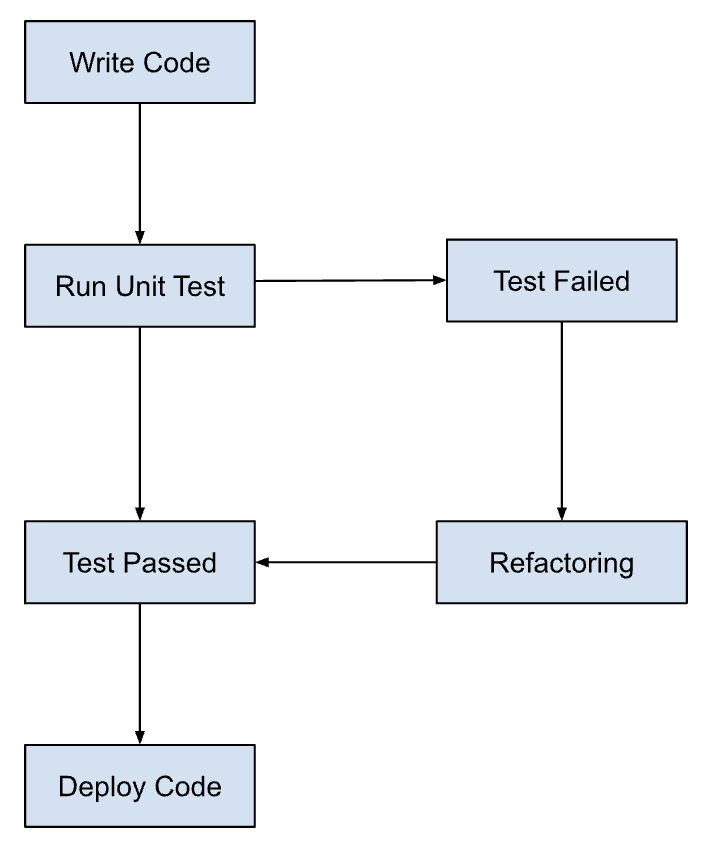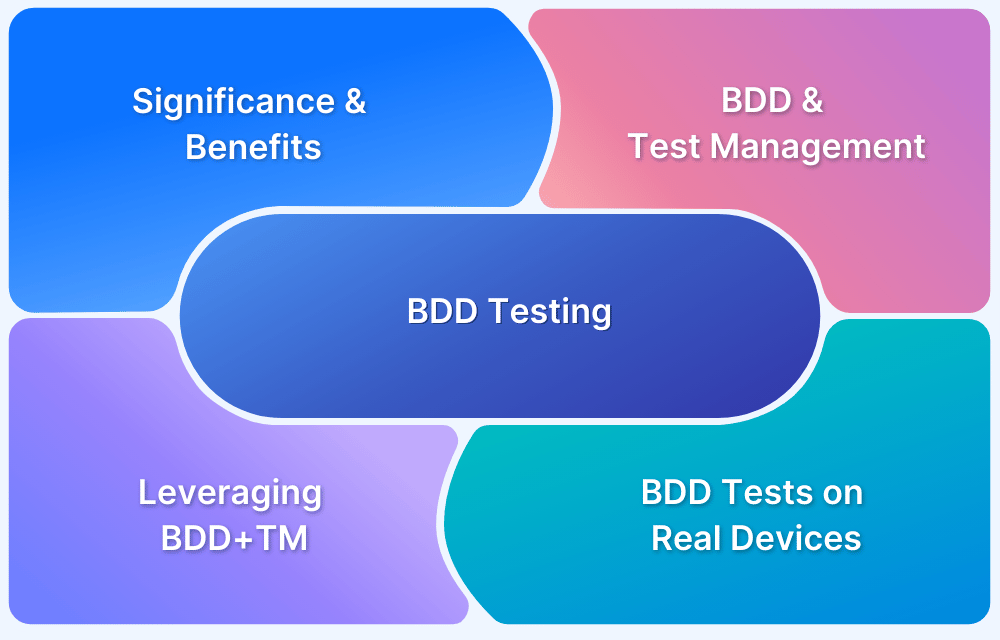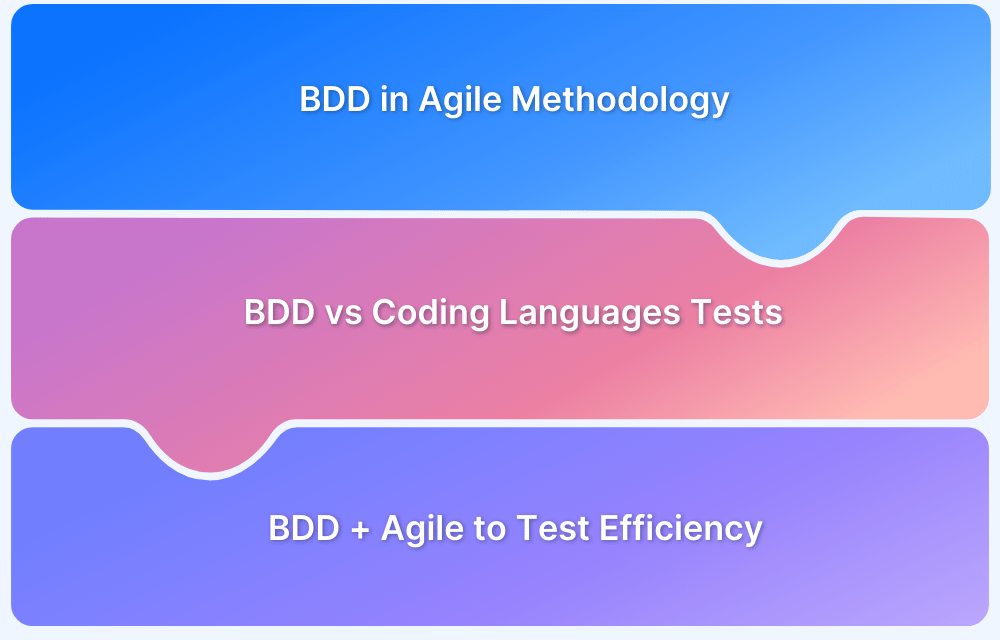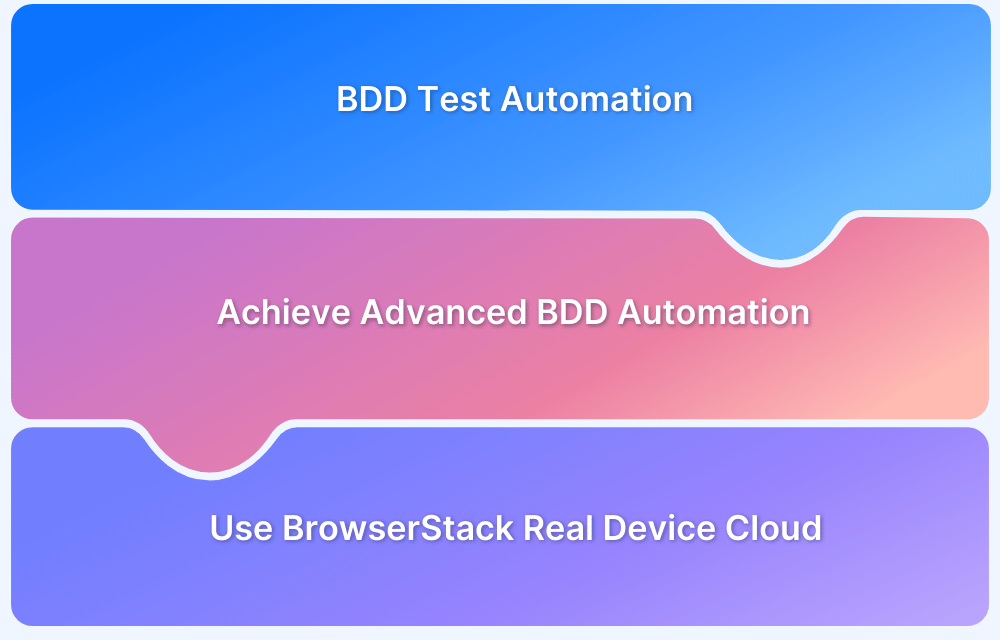Test-Driven Development (TDD), Behavior-Driven Development (BDD), and Acceptance Test-Driven Development (ATDD) are three distinct yet interconnected approaches that help developers create robust and reliable software.
TDD is primarily focused on unit testing and code functionality, BDD centers on system behavior and stakeholder collaboration, and ATDD aligns development with user requirements through acceptance criteria.
Understanding these distinctions can help teams leverage the strengths of each methodology, fostering a more efficient and effective development process.
What is Test-Driven Development (TDD)?
Test-Driven Development is a testing methodology or a programming practice implemented from a developer’s perspective. In this technique, a QA engineer starts designing and writing test cases for every small functionality of an application. This technique attempts to answer a simple question – Is the code valid?
The main intention of this technique is to modify or write a fresh code only when the test fails. Hence it results in lesser duplication of test scripts. This technique is prevalent mainly in agile development ecosystems. In a TDD approach, automated test scripts are written before functional pieces of code. The TDD methodology involves the following steps:
- A developer writes an automated test case based on the requirements specified in the documents.
- These tests are executed, and in some cases, they fail as they are developed before the development of an actual feature.
- The development team then re-factors the code for the test to pass successfully.
- TDD can be done by a single developer while writing both tests and application code side by side to complete a feature.
Refactoring refers to modifying the code without changing its main functionality or behavior.
Benefits of TDD
- Reduces the amount of time required for rework
- Explores bugs or errors very quickly
- Faster feedback
- Encourages the development of cleaner and better designs
- Enhances the productivity of the programmer
- Allows any team member to start working on the code without a specific team member. This encourages knowledge-sharing and collaboration.
- It gives the programmer confidence to change an application’s large architecture quickly.
- Results in the creation of extensive code that is flexible and easy to maintain
Now, let’s understand everything about Behavioral-Driven Development.
How to perform TDD?
Incorporating Test-Driven Development (TDD) into your software development process can significantly enhance code quality and reduce the likelihood of defects. By following the iterative cycle of writing a test, developing the code, and refactoring, teams can ensure that their software meets its requirements and is adaptable to future changes.
The structured approach outlined above helps to clarify the roles and responsibilities of various stakeholders, facilitating collaboration and efficiency throughout the development lifecycle.
| Step | Description | Stakeholders Involved |
|---|---|---|
| 1. Write a Test | Create a test for a small piece of functionality. This test should initially fail as the code does not yet exist. | Developers |
| 2. Run the Test | Execute the test suite to ensure the new test fails, confirming that the functionality is not implemented yet. | Developers |
| 3. Implement Code | Write the minimal amount of code required to pass the test. Focus on just enough implementation to satisfy the test condition. | Developers |
| 4. Run Tests Again | Run all tests again, including the new test, to check if the new code passes and does not break existing functionality. | Developers |
| 5. Refactor Code | Optimize the newly implemented code while keeping the functionality intact. This may involve cleaning up code, improving structure, or enhancing performance. | Developers |
| 6. Repeat | Continue this cycle for each new feature or piece of functionality, gradually building the application with a solid test suite. | Developers, Project Managers |
TDD Example
Let’s illustrate the Test-Driven Development (TDD) approach through a high-level example of creating a simple calculator that can perform addition.
Step 1: Write a Test
Define a test case for the functionality you want to implement such as, the addition of two numbers – “Adding 1 and 2, the result should be 3.”
Step 2: Run the Test
Execute the test. Since the addition function hasn’t been implemented yet, this test will fail, confirming that the functionality is currently absent.
Step 3: Implement Code
After the test fails, the next step is to write the minimum code necessary to make the test pass. It involves creating a function that performs the addition of the two numbers specified in the test.
Step 4: Run Tests Again
Run the test suite again, including the newly added test for the addition function. At this point, the addition test should pass, indicating that the implementation works as intended.
Step 5: Refactor Code
Once the test passes, the next step is to review the code for any potential improvements. This could involve simplifying logic, improving naming conventions, or optimizing performance while ensuring that the functionality remains intact.
Step 6: Repeat
Finally, the process is repeated for additional functionalities. For each new feature, you would write a test, run it to see it fail, implement the code, run the tests again to ensure it passes, and then refactor as necessary.
Popular TDD Frameworks
Various frameworks have been developed to facilitate TDD, Below are 5 popular TDD frameworks used across different programming languages and environments each with its own features, advantages, and limitations.
1. JUnit
JUnit is a widely used testing framework for Java applications. It provides annotations to identify test methods, assertions for testing expected outcomes, and a variety of tools for organizing and running tests.
Language: Java
Advantages:
- Easy Integration: Integrates seamlessly with popular IDEs and build tools like Maven and Gradle.
- Rich Ecosystem: A large ecosystem of extensions and plugins, enhancing functionality.
- Community Support: Extensive documentation and a strong community for support.
Limitations:
- Java-Centric: Primarily designed for Java, limiting its use in other languages.
- Steeper Learning Curve: For beginners, understanding its conventions and structure can be challenging.
2. NUnit
NUnit is a popular testing framework for .NET applications, providing a robust environment for writing and executing tests. It supports various types of assertions and allows for detailed test organization.
Language: .NET
Advantages:
- Flexible Test Structure: Supports multiple styles of test organization, making it versatile for different project needs.
- Rich Assertion Library: Offers a comprehensive set of assertions for testing various conditions.
- Cross-Platform: Works well across different .NET platforms, including .NET Core.
Limitations:
- Limited to .NET: Primarily focused on the .NET ecosystem, reducing its applicability in other languages.
- Configuration Complexity: Some users may find the initial setup and configuration cumbersome.
3. RSpec
RSpec is a behavior-driven development (BDD) framework for Ruby that emphasizes human-readable test specifications. While it is often used in a BDD context, it supports TDD practices effectively.
Language: Ruby
Advantages:
- Readable Syntax: Uses a natural language syntax, making tests easy to read and understand.
- Strong Community: Active community and extensive documentation provide valuable resources.
- Powerful Mocks and Stubs: Facilitates testing with powerful mocking and stubbing capabilities.
Limitations:
- Ruby Specificity: Primarily designed for Ruby applications, limiting its versatility for developers using other languages.
- Performance Overhead: Some users report that RSpec tests can be slower compared to other frameworks.
4. Mocha
Mocha is a flexible JavaScript testing framework that supports both TDD and BDD styles. It allows for asynchronous testing and integrates easily with various assertion libraries, making it versatile for frontend and backend testing.
Language: JavaScript
Advantages:
- Flexible: Supports multiple assertion libraries (like Chai), allowing developers to choose their preferred style.
- Asynchronous Testing: Provides robust support for testing asynchronous code, which is essential for modern JavaScript applications.
- Easy Setup: Simple to configure and start using, making it accessible for new developers.
Limitations:
- Limited Built-in Features: Unlike some other frameworks, Mocha has fewer built-in features and may require additional libraries for complete functionality.
- Potential Complexity: As tests grow in complexity, managing them effectively can become challenging.
5. PyTest
PyTest is a powerful testing framework for Python that supports TDD and BDD methodologies. It offers a simple syntax, detailed reporting, and a rich set of plugins, making it a popular choice among Python developers.
Language: Python
Advantages:
- Simple Syntax: Easy to write and understand tests, which is ideal for both beginners and experienced developers.
- Rich Plugin Ecosystem: Supports a wide array of plugins for extended functionality.
- Advanced Features: Offers features like fixtures and parameterized testing, enhancing testing capabilities.
Limitations:
- Learning Curve for Advanced Features: While the basics are easy, advanced features may require more time to learn.
- Potential for Confusion: New users may initially find the flexibility and variety of options overwhelming.
What is Behavioral-Driven Development (BDD)?
Behavioral-Driven Development (BDD) is a testing approach derived from the Test-Driven Development (TDD) methodology. In BDD, tests are mainly based on systems behavior. This approach defines various ways to develop a feature based on its behavior. In most cases, the Given-When-Then approach is used for writing test cases. Let’s take an example for a better understanding of TDD vs BDD:
- Given the user has entered valid login credentials
- When a user clicks on the login button
- Then display the successful validation message
As shown above, the behavior is illustrated in a very simple English language, a shared language. This helps everyone in the team responsible for development to understand the feature behavior.
Read More: How to achieve Advanced BDD Test Automation
For example, as shown in the video, one can try running an easy cross-browser test based on a set of instructions to test across multiple devices.
Try Cross Browser Testing for Free
Key benefits of BDD
- Helps reach a wider audience through the usage of non-technical language
- Focuses on how the system should behave from the customer’s and the developer’s perspective
- BDD is a cost-effective technique
- Reduces efforts needed to verify any post-deployment defects
The image below depicts a typical BDD operation:
How to perform BDD?
Behavior-Driven Development (BDD) is a collaborative approach that bridges the gap between technical and non-technical stakeholders by using a shared language to define software behavior. This methodology emphasizes understanding requirements through examples and scenarios, enabling teams to develop features that align closely with user needs.
Below is a structured overview of the steps involved in BDD, along with descriptions and the stakeholders typically involved in each step.
| Step | Description | Stakeholders Involved |
|---|---|---|
| 1. Identify Features | Collaborate with stakeholders to identify and prioritize features or functionalities needed for the software. | Product Owners, Business Analysts, Developers, Testers |
| 2. Write Scenarios | Create user stories and define acceptance criteria in the form of scenarios. Use a common language to describe expected behavior. | Product Owners, Business Analysts, Developers, Testers |
| 3. Review Scenarios | Conduct reviews of the scenarios with all stakeholders to ensure clarity and shared understanding of the requirements. | Product Owners, Business Analysts, Developers, Testers |
| 4. Implement Code | Developers write code to implement the functionality described in the scenarios, ensuring that it meets the acceptance criteria. | Developers |
| 5. Write Automated Tests | Create automated tests based on the defined scenarios. This often involves using BDD frameworks (e.g., Cucumber, SpecFlow). | Developers, Testers |
| 6. Run Tests | Execute the automated tests to verify that the implemented functionality behaves as expected. | Developers, Testers |
| 7. Refactor Code | Optimize and clean the code, ensuring that it remains maintainable while retaining the functionality described in the scenarios. | Developers |
| 8. Repeat | Continue the BDD cycle for new features or modifications, incorporating feedback and new requirements as necessary. | All Stakeholders |
BDD Example
An example for BDD is given below
Step 1. Identify Features: Collaborate with stakeholders to determine the need for a user login feature for authentication and security.
Step 2. Write Scenarios: Create user stories and acceptance criteria; for example:
- Successful Login: Given a registered user, when valid credentials are entered, then redirect to the dashboard.
- Unsuccessful Login: Given a registered user, when invalid credentials are entered, then display an error message.
Step 3. Review Scenarios: Validate scenarios with stakeholders to ensure shared understanding of requirements.
Step 4. Implement Code: Develop the login functionality, including the UI and backend authentication logic.
Step 5. Write Automated Tests: Use a BDD framework (e.g., Cucumber) to create tests based on the written scenarios.
Step 6. Run Tests: Execute automated tests; refine the implementation if tests initially fail.
Step 7. Refactor Code: Improve code for efficiency and readability without changing functionality once tests pass.
Step 8. Repeat: Iterate for additional features or modifications, writing and reviewing new scenarios as needed.
This concise approach highlights the iterative and collaborative nature of BDD, focusing on behavior to effectively meet user needs and enhance software quality.
Popular BDD Frameworks
Below are 5 popular BDD frameworks used across different programming languages and environments.
1. Cucumber
Cucumber is one of the most popular BDD frameworks, allowing users to write test scenarios in a natural language format (Gherkin). This makes it accessible to both technical and non-technical team members.
Advantages:
- Readable Syntax: Scenarios are written in plain language, making them easily understandable for all stakeholders.
- Cross-Language Support: Works with various programming languages, including Ruby, Java, and JavaScript.
- Strong Ecosystem: A large community and a wealth of resources, plugins, and tools for integration.
Limitations:
- Learning Curve: New users may find it challenging to understand the full ecosystem and how to integrate it effectively.
- Performance Overhead: As the number of scenarios grows, performance may become an issue, requiring careful management.
2. SpecFlow
SpecFlow is a BDD framework for .NET that allows users to define tests in Gherkin language, similar to Cucumber. It integrates seamlessly with Visual Studio and supports various testing frameworks.
Advantages:
- Integration with .NET: Strong integration with the .NET ecosystem, making it a great choice for C# developers.
- Rich Tooling: Supports IDE features like IntelliSense for Gherkin, enhancing productivity.
- Active Community: A supportive community and plenty of documentation are available.
Limitations:
- Limited to .NET: Primarily focused on the .NET platform, which may limit its use in projects involving other technologies.
- Complex Setup: Initial configuration can be more complicated than other BDD frameworks.
3. JBehave
JBehave is a BDD framework specifically designed for Java applications. It promotes writing tests in a narrative style, making it easy for non-technical stakeholders to understand.
Advantages:
- Java-Centric: Designed specifically for Java, providing robust support for Java applications.
- Narrative Style: Encourages writing tests in a more narrative and engaging format, enhancing clarity.
- Flexible Configuration: Offers extensive customization options for test execution and reporting.
Limitations:
- Steeper Learning Curve: Requires a deeper understanding of the framework and its conventions.
- Less Popular: Compared to Cucumber, it has a smaller community and fewer resources available.
4. Behat
Behat is a BDD framework for PHP applications that uses Gherkin syntax to describe behavior in plain language. It helps teams ensure that the software meets business requirements.
Advantages:
- PHP Integration: Specifically tailored for PHP, making it an ideal choice for PHP developers.
- Community and Documentation: A vibrant community and extensive documentation provide valuable support.
- Easy Setup: Simple to install and configure, allowing teams to get started quickly.
Limitations:
- Limited to PHP: Focused solely on PHP applications, which limits its use in projects involving other languages.
- Performance Issues: Can suffer from performance issues as the number of scenarios increases.
5. Robot Framework
Robot Framework is a generic open-source automation framework that supports BDD. It uses a keyword-driven approach, allowing for easy integration with various libraries and tools.
Advantages:
- Keyword-Driven: Allows users to create tests using keywords, making it accessible for non-technical users.
- Versatile: Can be used for testing web applications, APIs, and more, providing flexibility.
- Strong Community Support: A robust community and a wide range of libraries enhance its capabilities.
Limitations:
- Less Focused on BDD: While it supports BDD, it may not offer the same level of clarity and structure as more dedicated BDD frameworks.
- Learning Curve for Keywords: Users may need time to learn and understand how to effectively use keywords.
How does BDD enhance TDD?
Behavior-Driven Development (BDD) and Test-Driven Development (TDD) are complementary methodologies that can significantly improve software development processes. Here are five key ways BDD enhances TDD, supported by practical examples:
1. Shared Understanding Among Stakeholders
Example: In a project to develop an e-commerce platform, stakeholders (product owners, developers, and testers) collaborate to define user stories and scenarios for features like “User Registration.” The BDD approach ensures everyone understands the requirements by using clear, plain language, which in turn leads to more accurate TDD tests that reflect the actual needs of users.
2. Focus on User Behavior
Example: Consider developing a “Search Functionality” feature for a blog application. In BDD, scenarios like “When a user searches for a keyword, they should see a list of relevant articles” are defined upfront. This focus on user behavior allows TDD to create tests that not only check for code correctness but also ensure that the application meets user expectations.
3. Improved Test Coverage
Example: For a feature such as “User Login,” BDD might define multiple scenarios, including successful login, failed login due to incorrect password, and account lockout after multiple failed attempts. This comprehensive scenario writing results in TDD tests that cover a wider range of conditions, enhancing overall test coverage and reducing potential bugs.
4. Clearer Acceptance Criteria
Example: When developing a “Checkout Process” for an online store, BDD outlines specific scenarios like “As a user, I want to apply a discount code so that I can receive a discount on my purchase.” This clarity helps TDD focus on writing tests that validate not only the code implementation but also that the business logic aligns with user requirements, ensuring that acceptance criteria are met.
5. Facilitation of Refactoring
Example: During the implementation of a “Profile Update” feature, BDD scenarios help clarify what needs to be maintained through refactoring. As developers refactor code to improve performance or structure, they can rely on existing BDD scenarios and corresponding TDD tests to ensure that user-facing functionality remains intact, thereby increasing confidence in the codebase.
What is Acceptance Test-Driven development?
In the Acceptance Test-Driven Development (ATDD) technique, a single acceptance test is written from the user’s perspective, mainly focusing on satisfying the system’s functional behavior. This technique attempts to answer the question – Is the code working as expected?
This technique enhances collaboration among developers, users, and QAs with a shared focus on defining the acceptance criteria. The following are some of the key practices in ATDD:
- Analyzing and discussing the real-world scenarios
- Deciding the acceptance criteria for those test scenarios
- Automating the acceptance of test cases
- Focusing on the development of those requirement cases
Benefits of ATDD
- Requirements are very clearly analyzed without any ambiguity
- Encourages collaboration among cross-team members
- The acceptance test serves as a guide for the software development process
How to perform ATDD?
Acceptance Test-Driven Development (ATDD) is a collaborative approach that involves stakeholders—such as business analysts, developers, and testers—in defining acceptance criteria for user stories before development begins. This methodology ensures that the final product meets the specified requirements and expectations.
Below is a structured overview of the steps involved in ATDD, along with descriptions and the stakeholders typically involved in each step.
| Step | Description | Stakeholders Involved |
|---|---|---|
| 1. Define User Stories | Collaborate with stakeholders to write user stories that describe desired functionality from the user’s perspective. | Product Owners, Business Analysts, Developers, Testers |
| 2. Identify Acceptance Criteria | For each user story, define acceptance criteria that outline specific conditions that must be met for the story to be considered complete. | Product Owners, Business Analysts, Developers, Testers |
| 3. Write Acceptance Tests | Create acceptance tests based on the defined acceptance criteria. These tests should clearly outline the expected behavior of the system. | Product Owners, Business Analysts, Developers, Testers |
| 4. Review and Validate Tests | Conduct reviews of the acceptance tests with all stakeholders to ensure clarity and agreement on the acceptance criteria and expected outcomes. | Product Owners, Business Analysts, Developers, Testers |
| 5. Implement Code | Developers write the code to implement the functionality described in the user stories and acceptance tests. | Developers |
| 6. Execute Acceptance Tests | Run the acceptance tests to verify that the implemented functionality meets the specified criteria. | Developers, Testers |
| 7. Refactor Code | Review and optimize the code to improve maintainability and performance while ensuring that the acceptance tests still pass. | Developers |
| 8. Repeat for New Features | Continue the ATDD process for additional user stories or modifications, incorporating feedback and new requirements as necessary. | All Stakeholders |
ATDD Example
Step 1. Define User Stories: Collaborate with stakeholders to create a user story, e.g., “As a user who has forgotten my password, I want to reset it to regain account access.”
Step 2. Identify Acceptance Criteria: Outline conditions for success, such as:
- Requesting a password reset email.
- Email containing a secure reset link.
- User entering and confirming a new password that meets security requirements.
- Redirecting to the login page with a success message upon completion.
Step 3. Write Acceptance Tests: Create tests based on acceptance criteria, e.g.:
- Test Case 1: Request Password Reset: When the user requests a reset email, then the system sends it to the registered address.
- Test Case 2: Reset Password with Valid Link: When the user clicks the secure link and enters a valid new password, then the password is updated, and the user is redirected with a success message.
Step 4. Review and Validate Tests: Ensure all stakeholders agree on the acceptance tests and expected outcomes.
Step 5. Implement Code: Develop the password reset functionality, including secure link generation and the user interface.
Step 6. Execute Acceptance Tests: Run acceptance tests post-implementation; use feedback to make necessary adjustments if tests fail.
Step 7. Refactor Code: Improve code for efficiency and readability while ensuring functionality aligns with acceptance criteria.
Step 8. Repeat for New Features: Continue the ATDD process for additional features or modifications, defining and testing new user stories and acceptance criteria as needed.
Popular ATDD Frameworks
Below are 5 popular ATDD frameworks that are commonly used in software development:
1. FitNesse
Overview:
FitNesse is a web-based framework that allows teams to write acceptance tests in a tabular format using simple markdown-like syntax. It integrates with various programming languages and testing tools, making it versatile for different projects.
Advantages:
- Easy-to-Read Format: The tabular format makes it straightforward for non-technical stakeholders to understand the tests.
- Integration Capabilities: Supports integration with multiple programming languages and frameworks, allowing for flexibility.
- Collaboration: Encourages collaboration between business stakeholders and technical teams.
Limitations:
- Setup Complexity: Initial setup can be more complex than other frameworks.
- Limited Documentation: While there are resources available, comprehensive documentation can be lacking compared to more popular frameworks.
2. Cucumber
Overview:
Although primarily known as a BDD framework, Cucumber can also be used for ATDD by defining acceptance criteria in Gherkin language. It facilitates communication between technical and non-technical stakeholders through readable test cases.
Advantages:
- Natural Language Syntax: Scenarios written in Gherkin are easily understood by all team members, enhancing collaboration.
- Cross-Language Support: Works with various programming languages, including Java, Ruby, and JavaScript.
- Strong Community: A large community provides extensive resources, plugins, and support.
Limitations:
- Learning Curve: New users may take time to learn the framework and its integrations.
- Performance Issues: As the number of scenarios grows, performance can become a concern.
3. Robot Framework
Overview:
Robot Framework is an open-source automation framework that supports ATDD through a keyword-driven approach. It can be used for acceptance testing of web applications, APIs, and more.
Advantages:
- Keyword-Driven Testing: Allows users to create tests using simple keywords, making it accessible for non-technical users.
- Versatility: Suitable for various types of applications and supports numerous libraries for integration.
- Rich Ecosystem: A strong community and many plugins enhance its capabilities.
Limitations:
- Less Focused on ATDD: While it supports ATDD, it may not provide the same clarity and structure as frameworks specifically designed for this purpose.
- Learning Curve for Keywords: Users may need time to understand how to effectively use keywords for testing.
4. SpecFlow
Overview:
SpecFlow is a .NET-based framework that allows users to define acceptance tests in Gherkin syntax. It provides a seamless experience for C# developers, making it ideal for .NET projects.
Advantages:
- Integration with .NET: Strong integration with the .NET ecosystem and tools like Visual Studio enhances developer productivity.
- IntelliSense Support: Offers IDE features like IntelliSense for Gherkin, making writing tests easier.
- Active Community: A vibrant community and comprehensive documentation provide valuable resources.
Limitations:
- Limited to .NET: Primarily focused on .NET applications, limiting its use in projects involving other languages.
- Setup Complexity: Initial configuration can be complicated for new users.
5. Gauge
Overview:
Gauge is a light-weight test automation framework that allows for writing acceptance tests in a simple Markdown format. It supports multiple programming languages and promotes a behavior-driven approach to testing.
Advantages:
- Markdown Format: Easy to read and write tests in a simple, familiar format, making it accessible for non-technical stakeholders.
- Multi-Language Support: Works with various programming languages, providing flexibility in implementation.
- Dynamic Test Execution: Supports parameterized tests and dynamic test execution, enhancing test coverage.
Limitations:
- Less Established: Compared to other frameworks, Gauge has a smaller community and fewer resources.
- Learning Curve: Users may need time to understand its unique features and setup process.
Key Differences: TDD vs BDD vs ATDD
TDD, BDD, and ATDD serve distinct purposes in the software development lifecycle, each enhancing quality assurance in unique ways. TDD focuses on unit testing to ensure code correctness, BDD emphasizes collaboration and clarity in defining application behavior, and ATDD involves stakeholders in setting acceptance criteria to meet user needs.
Below is a comparison table highlighting the key differences among TDD, BDD, and ATDD.
| Parameter | TDD (Test-Driven Development) | BDD (Behavior-Driven Development) | ATDD (Acceptance Test-Driven Development) |
|---|---|---|---|
| Focus | Testing individual units of code before implementation | Specifying and validating the behavior of an application from the user’s perspective | Collaborating with stakeholders to define acceptance criteria and tests before development |
| Approach | Write tests first, then implement code to pass those tests | Write behavior specifications using natural language to ensure understanding among all stakeholders | Define acceptance criteria and tests collaboratively based on user stories |
| Stakeholders | Primarily developers | Developers, testers, product owners, and business analysts | Developers, testers, product owners, and business analysts |
| Test Type | Unit tests for individual components | High-level functional tests based on user stories | Acceptance tests that verify the software meets business requirements |
| Tools/Frameworks | JUnit, NUnit, PyTest, Mocha | Cucumber, SpecFlow, JBehave, Behat | FitNesse, Cucumber, Robot Framework, Gauge |
Conclusion
By understanding the key differences and the tools available for each methodology, teams can select the most appropriate approach for their projects, leading to higher quality software and greater alignment with business objectives.
Run tests on real devices to check website under real user conditions. BrowserStack Automate allows you to test on 3500+ real devices and browsers for a comprehensive and detailed testing experience.
